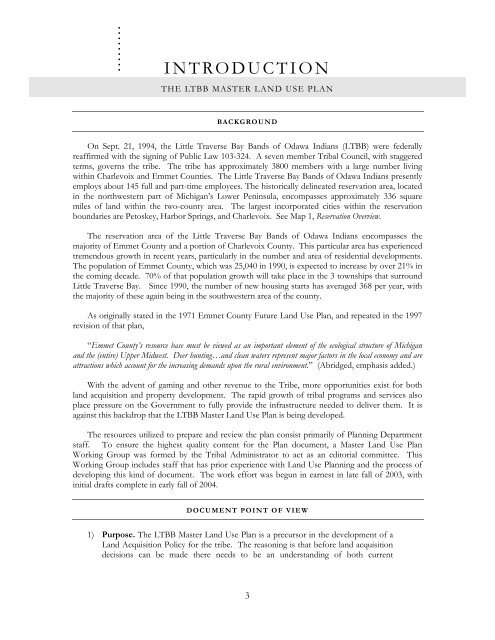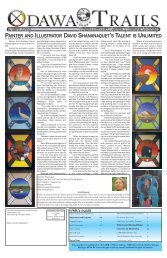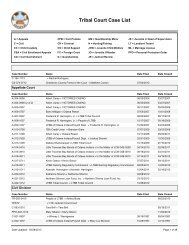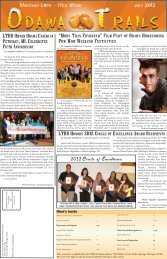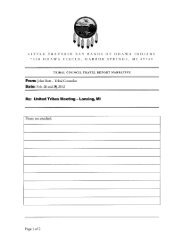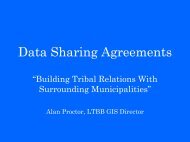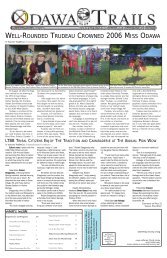LTBB Master Land Use Plan - Little Traverse Bay Bands of Odawa ...
LTBB Master Land Use Plan - Little Traverse Bay Bands of Odawa ...
LTBB Master Land Use Plan - Little Traverse Bay Bands of Odawa ...
You also want an ePaper? Increase the reach of your titles
YUMPU automatically turns print PDFs into web optimized ePapers that Google loves.
.<br />
INTRODUCTION<br />
THE <strong>LTBB</strong> MASTER LAND USE PLAN<br />
BACKGROUND<br />
On Sept. 21, 1994, the <strong>Little</strong> <strong>Traverse</strong> <strong>Bay</strong> <strong>Bands</strong> <strong>of</strong> <strong>Odawa</strong> Indians (<strong>LTBB</strong>) were federally<br />
reaffirmed with the signing <strong>of</strong> Public Law 103-324. A seven member Tribal Council, with staggered<br />
terms, governs the tribe. The tribe has approximately 3800 members with a large number living<br />
within Charlevoix and Emmet Counties. The <strong>Little</strong> <strong>Traverse</strong> <strong>Bay</strong> <strong>Bands</strong> <strong>of</strong> <strong>Odawa</strong> Indians presently<br />
employs about 145 full and part-time employees. The historically delineated reservation area, located<br />
in the northwestern part <strong>of</strong> Michigan’s Lower Peninsula, encompasses approximately 336 square<br />
miles <strong>of</strong> land within the two-county area. The largest incorporated cities within the reservation<br />
boundaries are Petoskey, Harbor Springs, and Charlevoix. See Map 1, Reservation Overview.<br />
The reservation area <strong>of</strong> the <strong>Little</strong> <strong>Traverse</strong> <strong>Bay</strong> <strong>Bands</strong> <strong>of</strong> <strong>Odawa</strong> Indians encompasses the<br />
majority <strong>of</strong> Emmet County and a portion <strong>of</strong> Charlevoix County. This particular area has experienced<br />
tremendous growth in recent years, particularly in the number and area <strong>of</strong> residential developments.<br />
The population <strong>of</strong> Emmet County, which was 25,040 in 1990, is expected to increase by over 21% in<br />
the coming decade. 70% <strong>of</strong> that population growth will take place in the 3 townships that surround<br />
<strong>Little</strong> <strong>Traverse</strong> <strong>Bay</strong>. Since 1990, the number <strong>of</strong> new housing starts has averaged 368 per year, with<br />
the majority <strong>of</strong> these again being in the southwestern area <strong>of</strong> the county.<br />
As originally stated in the 1971 Emmet County Future <strong>Land</strong> <strong>Use</strong> <strong>Plan</strong>, and repeated in the 1997<br />
revision <strong>of</strong> that plan,<br />
“Emmet County’s resource base must be viewed as an important element <strong>of</strong> the ecological structure <strong>of</strong> Michigan<br />
and the (entire) Upper Midwest. Deer hunting…and clean waters represent major factors in the local economy and are<br />
attractions which account for the increasing demands upon the rural environment.” (Abridged, emphasis added.)<br />
With the advent <strong>of</strong> gaming and other revenue to the Tribe, more opportunities exist for both<br />
land acquisition and property development. The rapid growth <strong>of</strong> tribal programs and services also<br />
place pressure on the Government to fully provide the infrastructure needed to deliver them. It is<br />
against this backdrop that the <strong>LTBB</strong> <strong>Master</strong> <strong>Land</strong> <strong>Use</strong> <strong>Plan</strong> is being developed.<br />
The resources utilized to prepare and review the plan consist primarily <strong>of</strong> <strong>Plan</strong>ning Department<br />
staff. To ensure the highest quality content for the <strong>Plan</strong> document, a <strong>Master</strong> <strong>Land</strong> <strong>Use</strong> <strong>Plan</strong><br />
Working Group was formed by the Tribal Administrator to act as an editorial committee. This<br />
Working Group includes staff that has prior experience with <strong>Land</strong> <strong>Use</strong> <strong>Plan</strong>ning and the process <strong>of</strong><br />
developing this kind <strong>of</strong> document. The work effort was begun in earnest in late fall <strong>of</strong> 2003, with<br />
initial drafts complete in early fall <strong>of</strong> 2004.<br />
DOCUMENT POINT OF VIEW<br />
1) Purpose. The <strong>LTBB</strong> <strong>Master</strong> <strong>Land</strong> <strong>Use</strong> <strong>Plan</strong> is a precursor in the development <strong>of</strong> a<br />
<strong>Land</strong> Acquisition Policy for the tribe. The reasoning is that before land acquisition<br />
decisions can be made there needs to be an understanding <strong>of</strong> both current<br />
3


